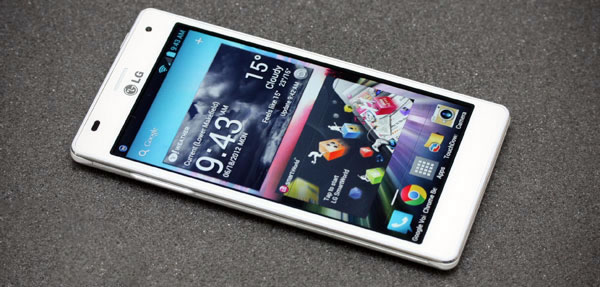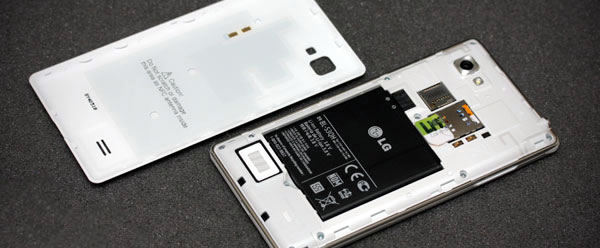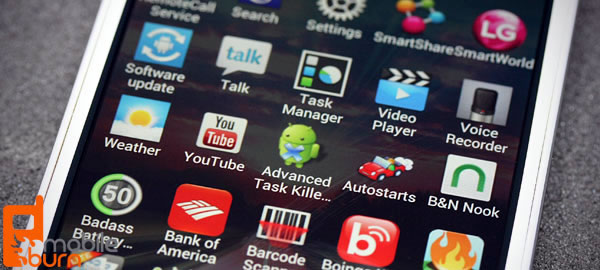
The LG Optimus 4X HD is a big phone, like most of the other flagship smartphones to hit the market this year. Due largely to its very nice 4.7-inch, IPS touchscreen display, which offers 720p HD resolution, LG's Optimus 4X HD measures 133.0 x 68.2mm x 9.5mm, which makes it slightly shorter and narrower than HTC's One X, but also half a hair thicker. At 133g in weight, the phone doesn't feel like a total brick in your purse or pocket.
The Optimus 4X HD features few external controls. The power button and the volume control are located on the top and left edges, respectively, and the three capacitive buttons for back, home, and menu sit below the display - hidden until activated. I'd have preferred the new standard Android 4.0 button layout, personally, but this Gingerbread style configuration will surely make upgrading users feel at home.

The textured rear cover of the phone comes off to reveal an NFC antenna on its underside. With the cover removed one can also spot the microSD memory card slot (empty) and a full sized SIM slot sitting above the battery. 16GB of storage are built into the phone, and the phone's namesake Nvidia Tegra 3 quad-core processor runs at a speed of 1.5GHz and is backed by a full gigabyte of RAM.
While the Optimus 4X HD's hardware is entirely functional, I find the design to be yawn-worthy. The white surfaces and chrome trim that the phone features remind me more of a kitchen appliance than a tech-heavy, modern smartphone. This is a shame because, as you'll soon learn, the phone is otherwise very capable and fun to use.
Usability
With the Optimus 4X HD, LG has done a fair bit to differentiate itself from stock Android while improving on a few things at the same time. The notification area, for example, offers a nice set of user-configurable shortcuts. The Optimus 4X HD's lock screen also offers both shortcuts and a number of different clock themes. LG's home screen system is pretty useful, allowing to easily customize home screen panels with shortcuts, widgets, and wallpapers, though the company was wise enough to leave the larger widget list available from the main app tray.
The app tray, however, is one of the things that went wrong on the Optimus 4X HD. While it offers separate tabs for all apps and downloaded apps, and allows users to rearrange things as they like, it doesn't offer the ability to just sort things alphabetically. Instead, it offers a "reset" function that puts all pre-loaded apps in their alphabetized state, and then tacks on the user downloaded apps to the end - alphabetized starting from 'a' again. It's largely useless. As such you start with "Alarm/Clock" going on up to "YouTube" showing the pre-installed apps, but right next to YouTube is, in my case, "B&N Nook" as the first downloaded app in alphabetical order.
LG includes a decent selection of widgets on the Optimus 4X HD, and I am particularly fond of the resizeable folders. LG's virtual keyboard works admirably well for text input tasks, but I found that the company's efforts came up a bit short when it came to the contacts application, which does not properly integrate social media status updates. Other features like LG's power-saving and quiet modes, its four home screen themes, and the Optimus 4X HD's full suite of gestures, fill out the device nicely.


Apart from that rather large shortcoming with the app tray, most of LG's user interface work is good. The phone is very smooth scrolling, and there's plenty of free RAM for user apps. The only bug I found had to do with quiet mode, which normally would allow the user to specify a time range when the phone would automatically disable notifications, ringers, and other sounds (apart from alarms). It seems that, while activated, any user initiated switches to silent, vibrate, or normal ringer modes will be randomly undone - as if they app fails to properly track the user's intended changes. It does work well at night, though, and I expect LG will address this bug in a future update.

Wireless Capabilities, NFC
While the international version of the LG Optimus 4X HD that I've been testing was not meant for the U.S. market, I found that it performed quite well on AT&T's HSPA network. Reception was solid, and data rates were quite reasonable, if not staggering. More importantly, I found that call audio on the Optimus 4X HD was very strong overall, which is something that a phone needs - smart or not.
In addition to the typical Bluetooth, Wi-Fi, and USB connectivity that the Optimus 4X HD offers, NFC is also supported. LG even includes a pair of re-programmable NFC tags that can be used with the Optimus 4X HD to switch between work and car configurations, for example, with a simple tap. Watch the video below to see a solid demo of how it all works.
LG's Optimus 4X HD includes a nice threaded SMS/MMS application for text and picture messaging. It doesn't offer any control over font sizes, which I find surprising, but it works well otherwise. The email app is also pretty solid, and it even supports a split-screen view when the Optimus 4X HD is held in a landscape orientation.
Google Talk is pre-loaded for instant messaging fans, and LG's own limited Twitter and Facebook support is also available, but IM users and social junkies will likely want to get additional applications from the Google Play Store to better support their vices.
